内科问诊
- 格式:docx
- 大小:12.11 KB
- 文档页数:5
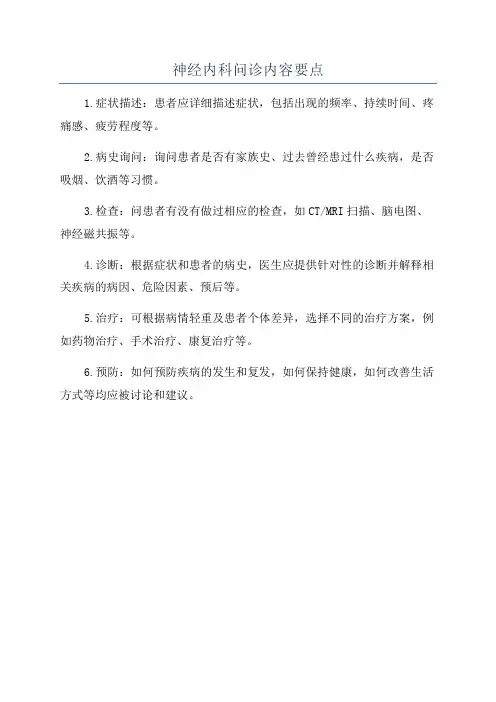
神经内科问诊内容要点
1.症状描述:患者应详细描述症状,包括出现的频率、持续时间、疼痛感、疲劳程度等。
2.病史询问:询问患者是否有家族史、过去曾经患过什么疾病,是否吸烟、饮酒等习惯。
3.检查:问患者有没有做过相应的检查,如CT/MRI扫描、脑电图、神经磁共振等。
4.诊断:根据症状和患者的病史,医生应提供针对性的诊断并解释相关疾病的病因、危险因素、预后等。
5.治疗:可根据病情轻重及患者个体差异,选择不同的治疗方案,例如药物治疗、手术治疗、康复治疗等。
6.预防:如何预防疾病的发生和复发,如何保持健康,如何改善生活方式等均应被讨论和建议。
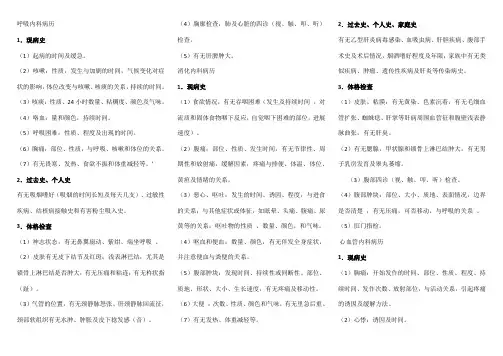
呼吸内科病历1.现病史(1)起病的时间及缓急。
(2)咳嗽:性质,发生与加剧的时间,气候变化对症状的影响,体位改变与咳嗽、咳痰的关系,持续的时间。
(3)咳痰:性质、24小时数量、粘稠度、颜色及气味。
(4)咯血:量和颜色,持续时间。
(5)呼吸困难:性质、程度及出现的时间。
(6)胸痛:部位、性质,与呼吸、咳嗽和体位的关系。
(7)有无畏寒、发热、食欲不振和体重减轻等。
’ 2.过去史、个人史有无吸烟嗜好(吸烟的时间长短及每天几支)、过敏性疾病、结核病接触史和有害粉尘吸入史。
3.体格检查(1)神志状态,有无鼻翼扇动、紫绀、端坐呼吸。
(2)皮肤有无皮下结节及红斑;浅表淋巴结,尤其是锁骨上淋巴结是否肿大,有无压痛和粘连;有无杵状指(趾)。
(3)气管的位置,有无颈静脉怒张、肝颈静脉回流征,颈部软组织有无水肿、肿胀及皮下捻发感(音)。
(4)胸廓检查,肺及心脏的四诊(视、触、叩、听)检查。
(5)有无肝脾肿大。
消化内科病历1.现病史(1)食欲情况,有无吞咽困难(发生及持续时间,对流质和固体食物咽下反应,自觉咽下困难的部位,进展速度)。
(2)腹痛:部位、性质、发生时间,有无节律性、周期性和放射痛,缓解因素,疼痛与排便、体温、体位、黄疸及情绪的关系。
(3)恶心、呕吐:发生的时间、诱因、程度,与进食的关系;与其他症状或体征,如眩晕、头痛、腹痛、尿黄等的关系;呕吐物的性质、数量、颜色,和气味。
(4)呕血和便血:数量、颜色,有无伴发全身症状,并注意便血与粪便的关系。
(5)腹部肿块:发现时间、持续性或间断性、部位、质地、形状、大小、生长速度,有无疼痛及移动性。
(6)大便:次数、性质、颜色和气味,有无里急后重。
(7)有无发热、体重减轻等。
2.过去史、个人史、家庭史有无乙型肝炎病毒感染、血吸虫病、肝胆疾病、腹部手术史及术后情况,烟酒嗜好程度及年限;家族中有无类似疾病、肿瘤、遗传性疾病及肝炎等传染病史。
3.体格检查(1)皮肤、粘膜:有无黄染、色素沉着,有无毛细血管扩张、蜘蛛痣、肝掌等肝病周围血管征和腹壁浅表静脉曲张,有无肝臭。

呼吸内科病历( 4)胸廓检查,肺及心脏的四诊(视、触、叩、听)2.过去史、个人史、家庭史1.现病史检查。
有无乙型肝炎病毒感染、血吸虫病、肝胆疾病、腹部手( 1)起病的时间及缓急。
( 5)有无肝脾肿大。
术史及术后情况,烟酒嗜好程度及年限;家族中有无类( 2)咳嗽:性质,发生与加剧的时间,气候变化对症消化内科病历似疾病、肿瘤、遗传性疾病及肝炎等传染病史。
状的影响,体位改变与咳嗽、咳痰的关系,持续的时间。
1.现病史3.体格检查( 3)咳痰:性质、 24 小时数量、粘稠度、颜色及气味。
( 1)食欲情况,有无吞咽困难(发生及持续时间,对( 1)皮肤、粘膜:有无黄染、色素沉着,有无毛细血( 4)咯血:量和颜色,持续时间。
流质和固体食物咽下反应,自觉咽下困难的部位,进展管扩张、蜘蛛痣、肝掌等肝病周围血管征和腹壁浅表静( 5)呼吸困难:性质、程度及出现的时间。
速度)。
脉曲张,有无肝臭。
( 6)胸痛:部位、性质,与呼吸、咳嗽和体位的关系。
( 2)腹痛:部位、性质、发生时间,有无节律性、周( 2)有无腮腺,甲状腺和锁骨上淋巴结肿大,有无男( 7)有无畏寒、发热、食欲不振和体重减轻等。
’期性和放射痛,缓解因素,疼痛与排便、体温、体位、子乳房发育及睾丸萎缩。
2.过去史、个人史黄疸及情绪的关系。
(3)腹部四诊(视、触、叩、听)检查。
有无吸烟嗜好(吸烟的时间长短及每天几支)、过敏性( 3)恶心、呕吐:发生的时间、诱因、程度,与进食( 4)腹部肿块:部位、大小、质地、表面情况,边界疾病、结核病接触史和有害粉尘吸入史。
的关系;与其他症状或体征,如眩晕、头痛、腹痛、尿是否清楚,有无压痛,可否移动,与呼吸的关系。
3.体格检查黄等的关系;呕吐物的性质、数量、颜色,和气味。
( 5)肛门指检。
( 1)神志状态,有无鼻翼扇动、紫绀、端坐呼吸。
( 4)呕血和便血:数量、颜色,有无伴发全身症状,心血管内科病历( 2)皮肤有无皮下结节及红斑;浅表淋巴结,尤其是并注意便血与粪便的关系。
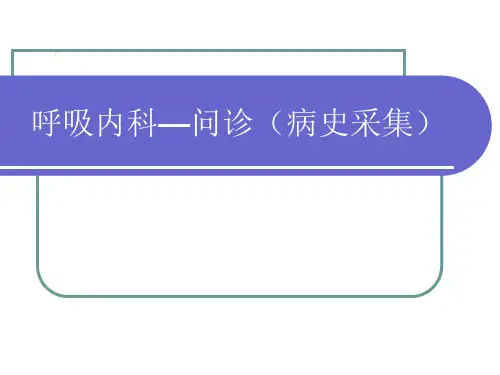
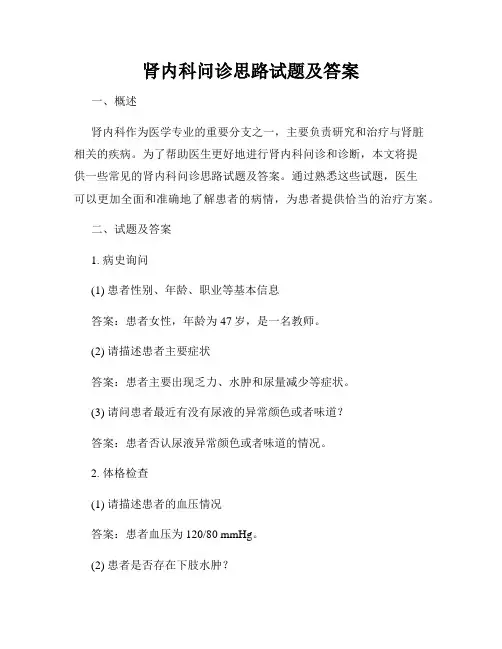
肾内科问诊思路试题及答案一、概述肾内科作为医学专业的重要分支之一,主要负责研究和治疗与肾脏相关的疾病。
为了帮助医生更好地进行肾内科问诊和诊断,本文将提供一些常见的肾内科问诊思路试题及答案。
通过熟悉这些试题,医生可以更加全面和准确地了解患者的病情,为患者提供恰当的治疗方案。
二、试题及答案1. 病史询问(1) 患者性别、年龄、职业等基本信息答案:患者女性,年龄为47岁,是一名教师。
(2) 请描述患者主要症状答案:患者主要出现乏力、水肿和尿量减少等症状。
(3) 请问患者最近有没有尿液的异常颜色或者味道?答案:患者否认尿液异常颜色或者味道的情况。
2. 体格检查(1) 请描述患者的血压情况答案:患者血压为120/80 mmHg。
(2) 患者是否存在下肢水肿?答案:是的,患者存在明显的下肢水肿。
(3) 请问患者是否有腹部包块?答案:患者腹部无明显包块。
3. 实验室检查(1) 请描述患者的尿检结果答案:患者的尿检结果显示蛋白尿和红细胞尿。
(2) 请问患者的血常规是否正常?答案:患者的血常规显示轻度贫血。
(3) 请问患者有无肾功能指标异常?答案:是的,患者存在肾功能指标异常,肌酐水平升高。
4. 影像学检查(1) 请问患者是否做过肾脏超声检查?答案:是的,患者做过肾脏超声检查。
(2) 肾脏超声结果如何?答案:肾脏超声显示肾盂扩张和肾小球增大。
(3) 是否需要进行其他影像学检查?答案:根据患者的具体情况,可能需要进一步进行CT扫描或MRI 检查。
5. 诊断(1) 根据以上问诊和检查结果,您认为患者可能患有什么疾病?答案:根据以上问诊和检查结果,患者可能患有肾炎。
(2) 诊断的依据是什么?答案:诊断的依据是患者出现乏力、水肿,尿检显示蛋白尿和红细胞尿,肾功能指标异常,以及肾脏超声显示肾盂扩张和肾小球增大等。
三、结语通过以上题目及答案的讨论,我们可以看到肾内科问诊的重要性和方法。
医生在了解患者病史、进行体格检查、实验室检查和影像学检查时,需要全面考虑患者的症状与指标变化,并结合临床经验进行综合判断和诊断。

呼吸内科病历1.现病史(1)起病的时间及缓急。
(2)咳嗽:性质,发生与加剧的时间,气候变化对症状的影响,体位改变与咳嗽、咳痰的关系,持续的时间.(3)咳痰:性质、24小时数量、粘稠度、颜色及气味。
(4)咯血:量和颜色,持续时间。
(5)呼吸困难:性质、程度及出现的时间。
(6)胸痛:部位、性质,与呼吸、咳嗽和体位的关系。
(7)有无畏寒、发热、食欲不振和体重减轻等。
’2.过去史、个人史有无吸烟嗜好(吸烟的时间长短及每天几支)、过敏性疾病、结核病接触史和有害粉尘吸入史.3.体格检查(1)神志状态,有无鼻翼扇动、紫绀、端坐呼吸. (2)皮肤有无皮下结节及红斑;浅表淋巴结,尤其是锁骨上淋巴结是否肿大,有无压痛和粘连;有无杵状指(趾)。
(3)气管的位置,有无颈静脉怒张、肝颈静脉回流征,颈部软组织有无水肿、肿胀及皮下捻发感(音).(4)胸廓检查,肺及心脏的四诊(视、触、叩、听)检查。
(5)有无肝脾肿大。
消化内科病历1.现病史(1)食欲情况,有无吞咽困难(发生及持续时间,对流质和固体食物咽下反应,自觉咽下困难的部位,进展速度).(2)腹痛:部位、性质、发生时间,有无节律性、周期性和放射痛,缓解因素,疼痛与排便、体温、体位、黄疸及情绪的关系。
(3)恶心、呕吐:发生的时间、诱因、程度,与进食的关系;与其他症状或体征,如眩晕、头痛、腹痛、尿黄等的关系;呕吐物的性质、数量、颜色,和气味.(4)呕血和便血:数量、颜色,有无伴发全身症状,并注意便血与粪便的关系。
(5)腹部肿块:发现时间、持续性或间断性、部位、质地、形状、大小、生长速度,有无疼痛及移动性.(6)大便:次数、性质、颜色和气味,有无里急后重。
(7)有无发热、体重减轻等.2.过去史、个人史、家庭史有无乙型肝炎病毒感染、血吸虫病、肝胆疾病、腹部手术史及术后情况,烟酒嗜好程度及年限;家族中有无类似疾病、肿瘤、遗传性疾病及肝炎等传染病史.3.体格检查(1)皮肤、粘膜:有无黄染、色素沉着,有无毛细血管扩张、蜘蛛痣、肝掌等肝病周围血管征和腹壁浅表静脉曲张,有无肝臭.(2)有无腮腺,甲状腺和锁骨上淋巴结肿大,有无男子乳房发育及睾丸萎缩。
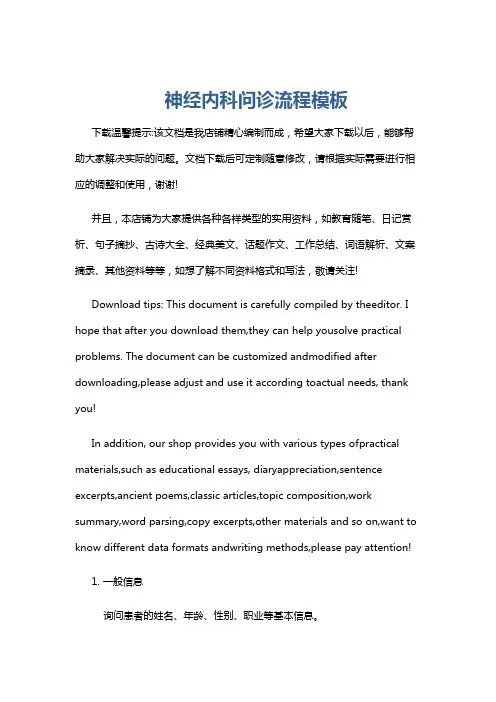
神经内科问诊流程模板下载温馨提示:该文档是我店铺精心编制而成,希望大家下载以后,能够帮助大家解决实际的问题。
文档下载后可定制随意修改,请根据实际需要进行相应的调整和使用,谢谢!并且,本店铺为大家提供各种各样类型的实用资料,如教育随笔、日记赏析、句子摘抄、古诗大全、经典美文、话题作文、工作总结、词语解析、文案摘录、其他资料等等,如想了解不同资料格式和写法,敬请关注!Download tips: This document is carefully compiled by theeditor. I hope that after you download them,they can help yousolve practical problems. The document can be customized andmodified after downloading,please adjust and use it according toactual needs, thank you!In addition, our shop provides you with various types ofpractical materials,such as educational essays, diaryappreciation,sentence excerpts,ancient poems,classic articles,topic composition,work summary,word parsing,copy excerpts,other materials and so on,want to know different data formats andwriting methods,please pay attention!1. 一般信息询问患者的姓名、年龄、性别、职业等基本信息。
了解患者的联系方式,以便后续沟通。
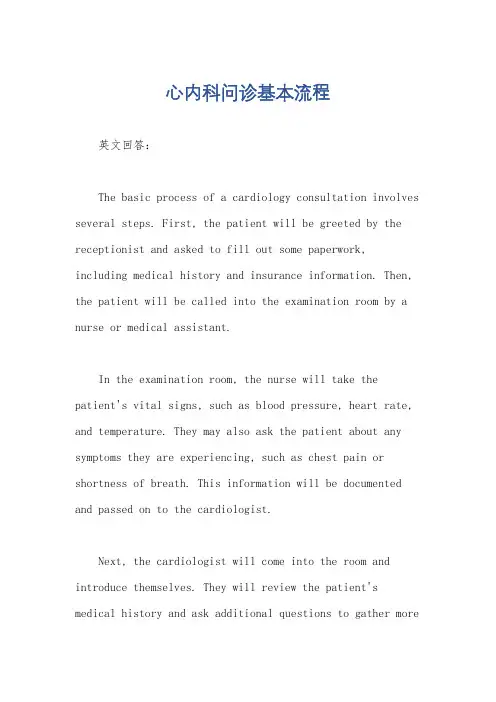
心内科问诊基本流程英文回答:The basic process of a cardiology consultation involves several steps. First, the patient will be greeted by the receptionist and asked to fill out some paperwork,including medical history and insurance information. Then, the patient will be called into the examination room by a nurse or medical assistant.In the examination room, the nurse will take thepatient's vital signs, such as blood pressure, heart rate, and temperature. They may also ask the patient about any symptoms they are experiencing, such as chest pain or shortness of breath. This information will be documented and passed on to the cardiologist.Next, the cardiologist will come into the room and introduce themselves. They will review the patient's medical history and ask additional questions to gather moredetails about the patient's symptoms and overall health. It is important for the patient to be honest and open during this discussion, as it will help the cardiologist make an accurate diagnosis.After the discussion, the cardiologist will perform a physical examination. This may involve listening to the patient's heart and lungs with a stethoscope, checking for any abnormalities or irregularities. The cardiologist may also examine the patient's extremities for signs of poor circulation or swelling.Based on the information gathered from the patient's history, symptoms, and physical examination, thecardiologist may order additional tests. These tests can include blood work, electrocardiogram (ECG), echocardiogram, stress test, or cardiac catheterization. The specific tests ordered will depend on the patient's individual case andthe suspected diagnosis.Once the test results are available, the cardiologist will review them and make a diagnosis. They will thendiscuss the diagnosis with the patient, explaining the condition and potential treatment options. The cardiologist may also answer any questions or concerns the patient may have.In some cases, the cardiologist may refer the patient to another specialist for further evaluation or treatment. For example, if a patient is diagnosed with a congenital heart defect, they may be referred to a cardiothoracic surgeon for surgical intervention.Overall, the process of a cardiology consultation involves gathering information, conducting a physical examination, ordering tests, making a diagnosis, and discussing treatment options with the patient. It is important for the patient to actively participate in the consultation by providing accurate information and asking questions.中文回答:心内科问诊的基本流程包括几个步骤。
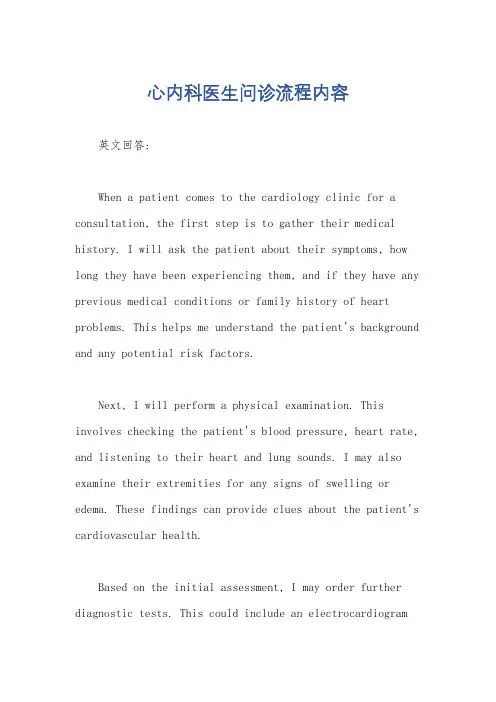
心内科医生问诊流程内容英文回答:When a patient comes to the cardiology clinic for a consultation, the first step is to gather their medical history. I will ask the patient about their symptoms, how long they have been experiencing them, and if they have any previous medical conditions or family history of heart problems. This helps me understand the patient's background and any potential risk factors.Next, I will perform a physical examination. This involves checking the patient's blood pressure, heart rate, and listening to their heart and lung sounds. I may also examine their extremities for any signs of swelling or edema. These findings can provide clues about the patient's cardiovascular health.Based on the initial assessment, I may order further diagnostic tests. This could include an electrocardiogram(ECG) to evaluate the electrical activity of the heart, an echocardiogram to assess the structure and function of the heart, or a stress test to evaluate the heart's response to physical activity. These tests help me gather more information about the patient's heart condition and guide the treatment plan.Once all the necessary information is gathered, I will discuss the diagnosis and treatment options with the patient. This includes explaining the nature of their heart condition, the potential risks and benefits of different treatment approaches, and answering any questions or concerns they may have. It is important to ensure that the patient fully understands their condition and is involvedin the decision-making process.After the consultation, I will schedule any necessary follow-up appointments and provide the patient with any prescriptions or referrals to other specialists, if needed. Follow-up care is crucial to monitor the patient's progress and make any necessary adjustments to their treatment plan.中文回答:当患者来到心内科门诊进行问诊时,首先要了解他们的病史。
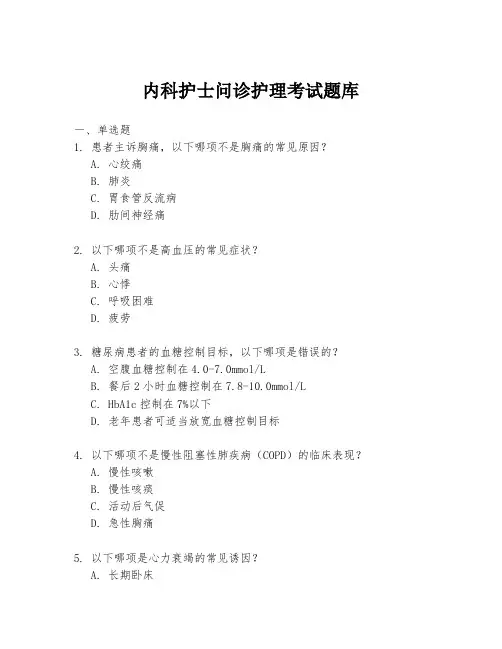
内科护士问诊护理考试题库一、单选题1. 患者主诉胸痛,以下哪项不是胸痛的常见原因?A. 心绞痛B. 肺炎C. 胃食管反流病D. 肋间神经痛2. 以下哪项不是高血压的常见症状?A. 头痛B. 心悸C. 呼吸困难D. 疲劳3. 糖尿病患者的血糖控制目标,以下哪项是错误的?A. 空腹血糖控制在4.0-7.0mmol/LB. 餐后2小时血糖控制在7.8-10.0mmol/LC. HbA1c控制在7%以下D. 老年患者可适当放宽血糖控制目标4. 以下哪项不是慢性阻塞性肺疾病(COPD)的临床表现?A. 慢性咳嗽B. 慢性咳痰C. 活动后气促D. 急性胸痛5. 以下哪项是心力衰竭的常见诱因?A. 长期卧床B. 过度劳累C. 情绪稳定D. 饮食清淡二、多选题6. 以下哪些是急性心肌梗死的危险因素?A. 高血压B. 吸烟C. 糖尿病D. 家族史E. 肥胖7. 以下哪些症状提示可能存在心力衰竭?A. 夜间阵发性呼吸困难B. 活动后气促C. 心悸D. 乏力E. 体重增加8. 以下哪些是糖尿病患者的护理措施?A. 监测血糖B. 饮食控制C. 适量运动D. 定期体检E. 服用降糖药物9. 以下哪些是肺炎的常见症状?A. 发热B. 咳嗽C. 咳痰D. 胸痛E. 呼吸困难10. 以下哪些是慢性肾脏病的临床表现?A. 尿量减少B. 浮肿C. 疲劳D. 贫血E. 高血压三、判断题11. 所有糖尿病患者都需要接受胰岛素治疗。
()12. 心力衰竭患者应限制钠盐摄入以减轻水肿。
()13. 慢性阻塞性肺疾病患者应避免吸烟以减缓病情进展。
()14. 急性心肌梗死患者应绝对卧床休息。
()15. 高血压患者应避免剧烈运动以防止血压急剧升高。
()四、简答题16. 简述高血压患者的饮食护理要点。
17. 描述糖尿病患者的自我管理方法。
18. 阐述心力衰竭患者的活动与休息指导。
19. 列出肺炎患者的护理措施。
20. 说明慢性肾脏病患者的护理注意事项。
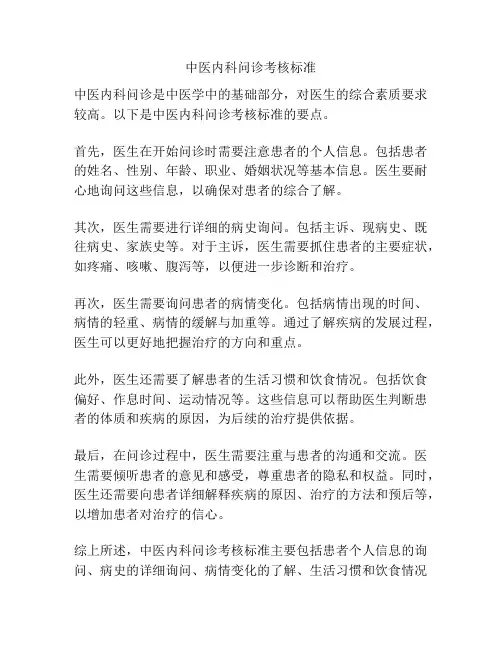
中医内科问诊考核标准
中医内科问诊是中医学中的基础部分,对医生的综合素质要求较高。
以下是中医内科问诊考核标准的要点。
首先,医生在开始问诊时需要注意患者的个人信息。
包括患者的姓名、性别、年龄、职业、婚姻状况等基本信息。
医生要耐心地询问这些信息,以确保对患者的综合了解。
其次,医生需要进行详细的病史询问。
包括主诉、现病史、既往病史、家族史等。
对于主诉,医生需要抓住患者的主要症状,如疼痛、咳嗽、腹泻等,以便进一步诊断和治疗。
再次,医生需要询问患者的病情变化。
包括病情出现的时间、病情的轻重、病情的缓解与加重等。
通过了解疾病的发展过程,医生可以更好地把握治疗的方向和重点。
此外,医生还需要了解患者的生活习惯和饮食情况。
包括饮食偏好、作息时间、运动情况等。
这些信息可以帮助医生判断患者的体质和疾病的原因,为后续的治疗提供依据。
最后,在问诊过程中,医生需要注重与患者的沟通和交流。
医生需要倾听患者的意见和感受,尊重患者的隐私和权益。
同时,医生还需要向患者详细解释疾病的原因、治疗的方法和预后等,以增加患者对治疗的信心。
综上所述,中医内科问诊考核标准主要包括患者个人信息的询问、病史的详细询问、病情变化的了解、生活习惯和饮食情况
的了解,以及与患者的有效沟通和交流。
通过这些考核标准,可以评判医生的专业素质和医患沟通的能力。
呼吸内科问诊表您的姓名 [填空题] *_________________________________您的性别? [单选题] *○女性○男性您的年龄?(周岁) [填空题] *_________________________________过敏史 [单选题] *○无○有对哪些药物过敏? [填空题] *_________________________________您的电话 [填空题] *_________________________________今天有什么症状?(如有多项症状,请全部选择) [多选题] *□咳嗽□痰□有哮鸣音□喘□胸痛□呼吸困难□发烧□其他: _________________有痰的患者,请选择痰的状态。
[多选题] *□白色□黄色□绿色□粉红色□带血□带泡沫□粘稠□稀薄症状具有怎样的特征? [单选题] *○不间断地,一直持续着○症状时有时无○渐渐严重○其他: _________________什么时候出现症状? [多选题] *□早晨□中午□傍晚□睡眠时□起床时□不定期□其他: _________________如果以数字来表达症状的程度,是多少?。
[单选题] *○0(完全没有)○1○2○3○4○5○6○7○8○9○10(最严重)该症状是从什么时候开始? [填空题] *如:2个月前_________________________________目前是否有在用的药物? [单选题] *○否○是 _________________填写药物名称,如:青霉素目前是否有在治疗的疾病,或者曾经治疗过的疾病? [单选题] *○无,既往身体健康○有目前是否有在治疗的呼吸系统疾病,或者曾经治疗过的呼吸系统疾病? [多选题] *□哮喘□慢阻肺□支气管扩张□肺纤维化□肺结核□肺部结节□肺血栓栓塞□肺动脉高压□肺心病□其他: _________________□无目前是否有在治疗的循环系统疾病,或者曾经治疗过的循环系统疾病? [多选题] *□高血压□冠心病□心律失常□心衰□其他: _________________□无目前是否有在治疗的消化系统疾病,或者曾经治疗过的消化系统疾病? [多选题] *□肝硬化□肝炎□慢性胃炎□胃溃疡□其他: _________________□无目前是否有在治疗的泌尿系统疾病,或者曾经治疗过的泌尿系统疾病? [多选题] *□慢性肾功能不全□肾、输尿管结石□尿路感染□其他: _________________□无目前是否有在治疗的神经系统疾病,或者曾经治疗过的神经系统疾病疾病? [多选题] *□脑梗塞□脑出血□癫痫□其他: _________________□无目前是否有在治疗的内分泌代谢疾病,或者曾经治疗过的内分泌代谢疾病? [多选题] *□糖尿病□高脂血症□甲亢□甲减□高尿酸血症□其他: _________________□无目前是否有在治疗的骨骼肌肉疾病,或者曾经治疗过的骨骼肌肉疾病? [多选题] *□风湿、类风湿□骨质疏松□痛风□膝关节病□其他: _________________□无目前是否有在治疗的妇科疾病,或者曾经治疗过的妇科疾病? [多选题] *□痛经□子宫肌瘤□不孕症□其他: _________________□无目前是否有在治疗的眼科疾病,或者曾经治疗过的眼科疾病? [多选题] *□白内障□视网膜病变□青光眼□其他: _________________□无目前是否有在治疗的耳鼻喉疾病,或者曾经治疗过的耳鼻喉疾病? [多选题] *□耳聋□耳鸣□头晕□其他: _________________□无目前是否有在治疗的精神疾病,或者曾经治疗过的精神疾病? [多选题] *□抑郁状态□焦虑状态□其他: _________________□无目前是否有在治疗的恶性肿瘤,或者曾经治疗过的恶性肿瘤? [多选题] *□肺癌□胃癌□肝癌□乳腺癌□其他: _________________□无目前是否有在治疗的血液病,或者曾经治疗过的血液病? [多选题] *□贫血□白血病□其他: _________________□无目前是否有在治疗的皮肤病,或者曾经治疗过的皮肤病? [多选题] *□湿疹□荨麻疹□银屑病□其他: _________________□无以前是否动过手术? [单选题] *○是○否因何疾病动过手术? [填空题] *_________________________________手术名称 [填空题] *_________________________________手术时间 [填空题] *_________________________________实施手术的医院 [填空题] *_________________________________是否有吸烟的习惯? [单选题] *○否○是○以前吸过,已戒烟吸烟量(支/每天) [填空题] *如:20_________________________________吸烟几年? [填空题] *_________________________________戒烟几年? [填空题] *_________________________________是否有以下症状? [多选题] *□晨起感到关节僵硬□关节酸痛□口干□眼干□无是否在怀孕,或者有怀孕的可能? [单选题] *○否○是目前是否在哺乳? [单选题] *○否○是身体感觉(可多选) [多选题] *□怕冷□怕热□怕风□忽冷忽热□上身热下身冷□下午潮热□无以上情况手脚 [单选题] *○手脚偏冷○手脚偏热○手脚心热烫○无以上情况 _________________出汗(身上有潮润感也算出汗)(可多选) [多选题] *□平时易出汗□稍活动大汗淋漓□基本不出汗□手足心出汗明显□半身出汗□仅头部出汗□睡觉时容易盗汗□无以上情况症状有没有随气候变化加重? [单选题] *○有○无头咽部是否有以下情况(可多选) [多选题] *□咽干□咽痛□咽痒□咽部异物感□鼻塞□清涕□浊涕□眼睛视物模糊□头痛□头昏□有眩晕感□无以上情况胸腹部是否有以下情况(可多选) [多选题] *□心慌□胸闷□气短□胸痛□胸部胀满□胃痛□胃胀满□有气从腹部上冲□两侧肋骨胀痛□下腹部隐隐作痛□无以上情况入睡 [单选题] *○困难○不困难睡眠质量 [单选题] *○睡眠深○睡眠浅梦 [单选题] *○多梦○梦少是否有以下情况(可多选) [多选题] *□白天犯困□午后犯困□饭后犯困□精神疲倦□嗜睡□睡觉流口水□无以上情况情绪(可多选) [多选题] *□易怒□易烦躁□易悲伤□易抑郁□易受惊□爱叹气□思虑较多□无以上情况小便(可多选) [多选题] *□小便多□小便少□尿急□尿不尽□遗尿□小便刺痛□尿热烫□尿血□正常(5-8次)大便 [单选题] *○一天一次○一天几次○几天一次○长期便秘大便形状 [多选题] *□细条□不成形□球状大便质地 [单选题] *○偏干○偏稀○黏马桶○腹泻○正常大便是否有以下情况(可多选) [多选题] *□放屁多□放屁臭□大便有时灼热□大便不爽(想拉但拉得不痛快)□无以上情况胃口 [单选题] *○好○一般○较差○吃得多但都容易饿○想吃但吃不下喝水 [单选题] *○喝水多○喝水少○口渴但不喜喝水○口渴想大量喝水○正常喜欢喝 [单选题] *○温热水○无偏好口中感觉 [单选题] *○苦○黏○酸○淡○晨起口苦○嘴干○热○麻○无以上情况是否有以下情况(可多选) [多选题] *□打嗝□反酸□胀气□口气□恶心□吞咽困难□食道烧灼感□胃有烧心感□无以上情况是否绝经 [单选题] *○否经期天数(月经来几天) [单选题] *○1~3天○4~7天○8~15天○16天以上周期天数(多久来一次) [单选题] *○经期不规律○小于20天○21~35天○36~60天○61天以上痛经 [单选题] *○是○否经色 [单选题] *○暗黑○褐色○鲜红○淡红血块 [单选题] *○有。
求一份心内科问诊模板
首先了解患者一般情况如:患者年龄、性别、职业、婚姻情况、吸烟、饮酒不、既往得过什么病等
然后本次就诊的主要原因与症状时间
根据其症状展开来问
1.胸痛:部位,性质,持续时间,缓解方式,诱因,伴随症状,有无放射。
关于胸痛问诊我会问哪些伴随症状,因此想到哪些鉴别诊断。
首先在自己脑海里一定要想到哪些疾病可致胸痛,比如:急性胸痛,急性心肌梗塞、主动脉夹层,肺栓塞、气胸,急腹症。
慢性胸痛:稳定性心绞痛,胸壁疾病,消化系统疾病。
围绕这些疾病来问还有哪些伴随症状,慢慢排除每一个疾病。
但这样毫无次序就怕问漏掉,所以对于每一个患者,每一个症状,我们都分系统,神经系统、消化系统、呼吸系统,循环系统及内分泌系统,这样鉴别诊断就要全面一些,误诊机会也少些。
2.心悸:发生时间,诱因,持续时间,缓解方式,伴随症状。
(以下就不展开了,太多了,就列个提纲)
3.头晕,头痛,晕厥:发生时间,诱因,发作频繁程度,持续时间,缓解方式,伴随症状。
4.咳嗽,咯血
5.水肿
6.呼吸困难:与体位或体力活动有关否
7.高血压,心功能不全,风湿热。
中医内科问诊考试题及答案考试题:1. 中医内科的研究范围主要包括哪些方面?2. 病人来诊时,中医内科医生应该如何进行全面的问诊?3. 在中医内科问诊中,常用的四诊法是指什么?各有哪些内容?4. 中医内科问诊时,有哪些特定的注意事项?5. 病人描述自己的症状时,医生应该如何进行进一步的跟进和询问?6. 中医内科问诊的过程中,医生需要收集哪些信息,以便帮助正确诊断和制定治疗计划?7. 中医内科问诊的目的是什么?如何根据病人所述症状进行辩证论治?答案:1. 中医内科的研究范围主要包括疾病的诊断与治疗、疾病的预防、健康的保障及疾病的预测等方面。
2. 在病人来诊时,中医内科医生应该进行全面的问诊,包括病史、主诉、既往史、家族史、个人生活史等方面的询问。
医生应该耐心倾听,并记录相关信息。
3. 常用的四诊法是望诊、闻诊、问诊和切诊。
望诊是通过观察病人面色、舌苔、舌质等来了解病情;闻诊是通过闻病人的气味、声音等来判断病情;问诊是向病人询问相关病史、症状等信息,包括寒热、疼痛、口渴等;切诊是通过触摸病人脉搏、皮肤等来判断病情。
4. 中医内科问诊时,医生需要注意以下事项:- 保持病人的隐私和尊严,在问诊过程中进行适当的解释和提醒;- 确保问诊环境安静、整洁,有利于病人的放松和舒适;- 在问诊过程中,医生应该注意病人言行举止,观察其面色、精神状态等;- 在病人回答问题时,医生要避免干扰、引导,保持病人的真实回答。
5. 当病人描述症状时,医生可以进行进一步的跟进和询问,以更全面地了解病情。
医生可以询问病人症状的时间、部位、性质、病程等相关信息,并结合其他诊断手段,如望、闻、切等方法来进一步判断。
6. 中医内科问诊的过程中,医生需要收集病人的病史、主诉、既往史、家族史、个人生活史等信息。
此外,医生还需要了解病人的体格检查、辅助检查等结果,以便进行正确的诊断和制定治疗计划。
7. 中医内科问诊的目的是为了全面了解病人的病情,确定其具体的病证,并根据病人所述症状进行辩证论治。
临床技能学习速查手册之一(问诊及病历书写)临床技能学习速查手册之一问诊及病历书写说明问诊及病历书写是临床医生的基本技能,为配合2003级临床医学专业学生的临床技能培训,特按照国家级规划教材第六版《诊断学》的内容和昆明医学院毕业实习大纲的要求,编写《临床技能学习速查手册—问诊及病历书写》供学生复习及掌握问诊及病历书写的内容和方法。
本手册突出了学习的内容要点,便于学生携带和记忆知识点。
由于时间仓促,如有遗漏的内容或与诊断学教材冲突之处,请教师予以补充和更正。
目录问诊内容…………………………………………………………………………………………主要症状问诊要点………………………………………………………………………………发热…………………………………………………………………………………………疼痛(头痛、胸痛、腹痛、关节痛)……………………………………………………水肿…………………………………………………………………………………………呼吸困难……………………………………………………………………………………咳嗽与咳痰…………………………………………………………………………………咯血…………………………………………………………………………………………恶心与呕吐…………………………………………………………………………………呕血…………………………………………………………………………………………便血…………………………………………………………………………………………腹泻…………………………………………………………………………………………黄疸…………………………………………………………………………………………惊厥…………………………………………………………………………………………意识障碍……………………………………………………………………………………少尿、多尿、血尿…………………………………………………………………………休克…………………………………………………………………………………………内科实习常见疾病问诊要点……………………………………………………………………心力衰竭……………………………………………………………………………………心脏瓣膜病(二狭、二闭、主狭、主闭)………………………………………………心包炎………………………………………………………………………………………心肌病………………………………………………………………………………………高血压病……………………………………………………………………………………冠心病………………………………………………………………………………………常见心律失常………………………………………………………………………………胃炎…………………………………………………………………………………………急性胰腺炎…………………………………………………………………………………肝硬化………………………………………………………………………………………原发性肝癌…………………………………………………………………………………肝性脑病……………………………………………………………………………………肠结核或结核性腹膜炎……………………………………………………………………贫血(缺铁性、再生障碍性、溶血性)…………………………………………………白血病………………………………………………………………………………………血小板减少性紫癜…………………………………………………………………………淋巴瘤………………………………………………………………………………………慢性肾小球肾炎……………………………………………………………………………肾病综合症…………………………………………………………………………………肾盂肾炎……………………………………………………………………………………肾功能不全…………………………………………………………………………………肺炎(肺炎球菌、葡萄球菌、肺炎支原体)……………………………………………支气管炎……………………………………………………………………………………慢性阻塞性肺病……………………………………………………………………………慢性肺源性心脏病…………………………………………………………………………慢性呼吸衰竭………………………………………………………………………………支气管哮喘…………………………………………………………………………………肺结核………………………………………………………………………………………胸腔积液……………………………………………………………………………………肺脓肿………………………………………………………………………………………糖尿病………………………………………………………………………………………甲状腺机能亢进……………………………………………………………………………其他科室实习常见疾病问诊要点………………………………………………………………问诊用语规范……………………………………………………………………………………住院病历书写……………………………………………………………………………………住院病历书写内容…………………………………………………………………………病程记录书写内容…………………………………………………………………………其他专项病程记录书写内容………………………………………………………………交(接)班记录……………………………………………………………………………实习轮转科室住院病历书写注意事项……………………………………………………门诊病历书写……………………………………………………………………………………初诊门诊病历书写内容……………………………………………………………………复诊门诊病历书写内容……………………………………………………………………参考书目…………………………………………………………………………………………问诊内容一、一般项目姓名、性别、年龄、民族、婚姻、地址、工作单位、职业、入院日期、记录日期、病史陈诉者及可靠程度。
中医内科学(规培出站SP问诊)肺系疾病(感冒、咳嗽、哮病、喘证、肺痨、肺痈、肺胀、肺癌)咳嗽中医类证鉴别:哮证,喘证,肺痨西医:急性支气管炎、慢性支气管炎、肺炎、肺结核、肺癌、肺脓肿、支气管扩张、肺心病,花粉、异物导致的过敏问诊部分1.介绍自己:您好,我是你的接诊医生,我姓王;2.询问病人的基本信息:请问你的姓名,年龄,工作;3.此次就诊的原因:你这次来主要是什么不舒服(咳嗽);4.发病的时间:什么时候开始咳嗽了,持续多久了;5.诱因:这之前有无受凉、气候变化,劳累、饮食或者情志变化;6.主症特点:咳嗽的声音(犬吠样咳嗽、高调金属音、无声低咳、痉挛样呛咳)节律(一天咳多少次,大约每次咳嗽多久),时间(早上还是晚上咳的厉害),程度,咳痰(色、质、量、味);7.伴随症状与鉴别症状:有没有发热恶寒、出汗、怕冷、头痛、鼻塞流涕、打喷嚏,有没有咽干、咽痒、咽痛、咽中异物感、喉中水鸡鸣,有没有乏力、咯血、盗汗、消瘦,有没有胸闷、胸痛、心慌、气喘、呼吸困难,有没有腹痛腹泻。
8.既往类似情况:以前有没有类似的情况,当时是什么样子,有没有就诊过,当时的检查,诊断,治疗,预后;9.此次就诊情况与变化:这次有没有看过医生,检查,诊断,治疗,症状有没有缓解;10.刻下(包括十问):现在是否有咳嗽咳痰;平时怕冷还是怕热,容易出汗吗?有没有头晕头痛、有没有口干口苦、平时喜欢喝冷的还是热的、有没有耳鸣、有没有腰酸、疲倦乏力、吃饭睡觉,大小便情况11.既往史:有没有慢性支气管炎、哮喘,有没有高血压、心脏病、糖尿病等慢性病史;有没有肝炎、结核等传染病史;有没有手术外伤史;有没有输血、防接种史;12.过敏史:有没有啥药物食物过敏;13.个人史:出生并生长于哪里,平时工作干嘛,有没有工业粉尘、毒物等接触病史,最近有没有出去旅游(流行病)?有无抽烟喝酒?14.婚育史:结婚了吗,生了几个小孩,配偶和小孩身体好吗?15.月经史:初潮是什么时候,一般几天来一次月经,每次月经大概几天,上次月经什么时候,平时痛经吗?16.家族史:父母身体状况,有无慢支、哮喘等疾病;兄弟姐妹的身体状况诊断与治疗1.诊断西医:慢性阻塞性肺疾病中医:咳嗽2.治疗西医:进一步检查:血常规+CRP,痰培养+药敏,结核试验,痰找脱落细胞、肿瘤标志物、胸片或胸部CT;休息,清淡饮食,多饮水,止咳化痰,根据培养选择适当的抗生素;中枢性镇咳药:新泰洛奇口服液;抗组胺:酮替芬;白三烯拮抗剂:顺尔宁;化痰:溴己新;中医:风寒袭肺证——疏风宣肺,化痰止咳——止嗽散;桔梗、甘草、白前、荆芥、陈皮、紫菀、百部、生姜体格检查部分1.告知患者:您好,接下来我要为你做一个体格检查;2.戴好口罩帽子,洗手;3.协助患者摆好姿势;4.望诊:患者发育良好、体征匀称、营养中等、急性面容、表情自然、自主体位;神志清楚、呼吸平稳;全身及皮肤黏膜正常,无皮疹,未见皮下出血;皮肤状况正常,弹性正常,无水肿;无肝掌;无蜘蛛痣及其他;颜面无水肿;口唇无发绀,肢端无紫绀,无杵状指5.眼睛巩膜:无黄染球结膜:拇指和示指将上下眼睑分开,嘱患者向上、下、左、右转动眼球球结膜无充血水肿睑结膜:无苍白(检查下,拇指按住下眼睑,嘱患者向上看;检查上,嘱患者向下看,拇指和示指向上捻转翻开上眼睑,检查完让患者向上看恢复正常位置)6.咽喉:(患者头稍后仰,口长大发啊,压舌板压在前2/3与后1/3的交界处)患者咽淡,无粘膜充血、红肿,咽后壁淋巴滤泡无增生,扁桃体未见肿大,无渗出物)7.气管:居中8.浅表淋巴结触诊(颌下、颏下、颈后、颈前、锁骨上、锁骨下)(触诊顺序:耳前,耳后,乳突,枕后,颌下,颏下,颈后,颈前,锁骨上,腋窝下(顶、前、内、后、外),滑车,腹股沟、腘窝)浅表淋巴结未触及肿大9.①颈静脉充盈:(坐位及半卧位)未见颈静脉怒张②肝颈静脉反流征:(右手压在右腹部,观察颈静脉怒张更加明显,则为阳性):肝颈静脉反流征阴性10.肺部:(1)视诊(先俯视,再平视)——患者胸廓外形正常,胸部皮肤无皮疹,无出血点,肋间隙正常,无三凹征,(胸式呼吸),呼吸平稳,每分钟16次,深度及节律均匀而整齐,双侧呼吸运动均衡、对称(2)触诊:①胸廓活动度——呼吸运动(深吸气,两手拇指在胸骨下端前正中线相遇)两侧胸廓活动度一致②触觉语颤(嘱患者发“一”,用两手掌/手掌尺侧缘,从上往下,由内向外,左右对比;再到背部)两侧触觉语颤一致③胸膜摩擦感(嘱患者深吸气双手掌置于腋中线第5-7肋)无胸膜摩檫感(3)叩诊:①肺大体叩诊(由左到右,由外向内,自上而下,从第一肋间隙到第四肋间隙(找到胸骨角,确定第二肋))②肺下界叩诊(只用叩右侧,沿右锁骨中线、右腋中线,右锁骨中线从第四肋,清——浊(第五肋间),浊到实(第六肋间),即为肺下界;右腋中线第8肋间)③肺下界活动度(沿右锁骨中线、右肩胛线,先叩肺下界,嘱患者深吸气时屏住,继续往下叩,清-浊;平静呼吸,嘱患者深呼气时屏住)两肺叩诊呈清音,肺下界叩诊在右锁骨中线第6肋间隙、右腋中线第8肋间隙,肺下界移动度在6-8cm。
摘要:本报告通过对中医内科学问诊实训的亲身经历,详细记录了实训过程中的问诊技巧、诊断思路以及所学到的中医理论知识。
通过本次实训,我深刻认识到中医问诊的重要性,并学会了如何运用中医理论进行诊断。
以下为实训报告的具体内容。
一、实训背景随着现代医学的快速发展,中医学在我国医疗事业中扮演着越来越重要的角色。
为了提高中医临床诊疗水平,我参加了中医内科学问诊实训。
本次实训旨在通过模拟临床病例,让我掌握中医问诊技巧,提高诊断能力。
二、实训过程1. 实训准备在实训前,我认真复习了中医内科学的相关理论知识,包括中医基础理论、脏腑学说、病因病机等。
同时,我还查阅了相关文献,了解了常见病的中医诊断方法。
2. 模拟问诊实训过程中,我分别对三位患者进行了问诊。
以下是三位患者的具体病情:(1)患者一:男性,45岁,主诉:反复夜间胃脘部疼痛2个月。
问诊内容:- 一般情况:询问患者姓名、年龄、职业、婚姻状况等。
- 主诉:询问疼痛的部位、性质、程度、持续时间等。
- 现病史:询问疼痛的起病时间、诱因、加重或缓解因素等。
- 既往史:询问患者是否有胃病、心脏病等病史。
- 个人史:询问患者饮食习惯、生活习惯等。
- 家族史:询问患者家族中是否有类似疾病史。
(2)患者二:女性,60岁,主诉:咳嗽、咳痰2周。
问诊内容:- 一般情况:询问患者姓名、年龄、职业、婚姻状况等。
- 主诉:询问咳嗽的部位、性质、程度、持续时间等。
- 现病史:询问咳嗽的起病时间、诱因、加重或缓解因素等。
- 既往史:询问患者是否有慢性支气管炎、哮喘等病史。
- 个人史:询问患者吸烟史、职业暴露史等。
- 家族史:询问患者家族中是否有类似疾病史。
(3)患者三:男性,50岁,主诉:头晕、头痛、失眠1个月。
问诊内容:- 一般情况:询问患者姓名、年龄、职业、婚姻状况等。
- 主诉:询问头晕、头痛的部位、性质、程度、持续时间等。
- 现病史:询问头晕、头痛的起病时间、诱因、加重或缓解因素等。